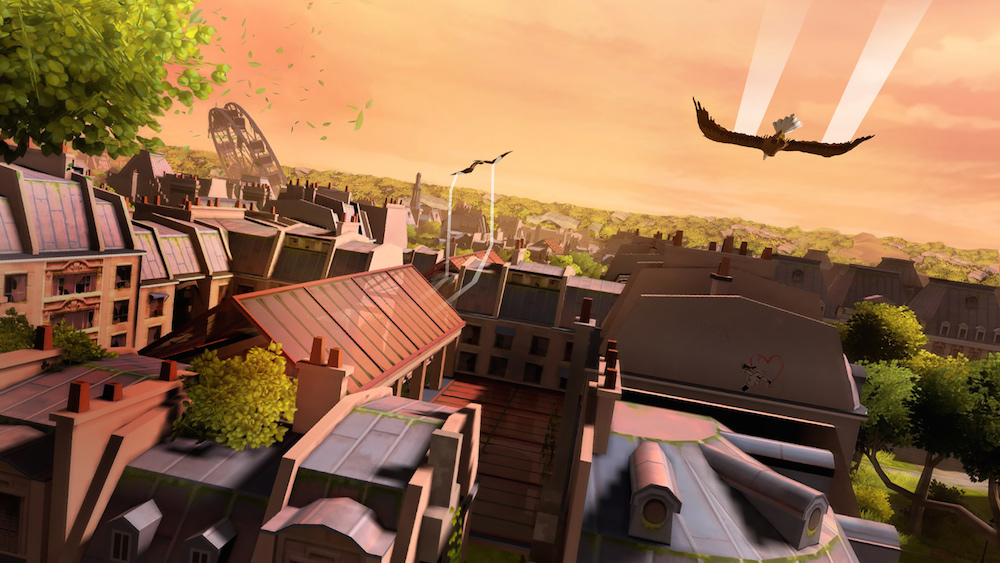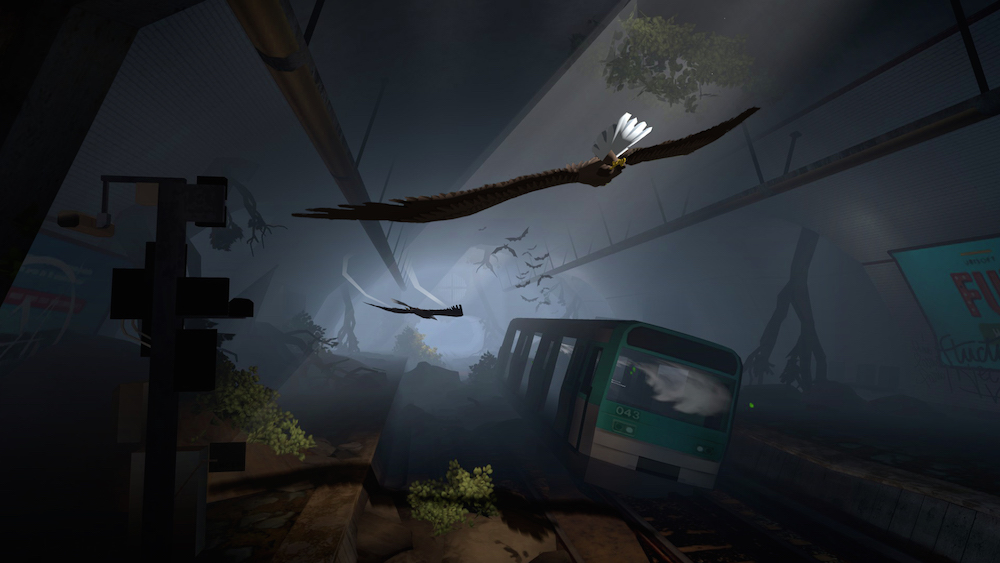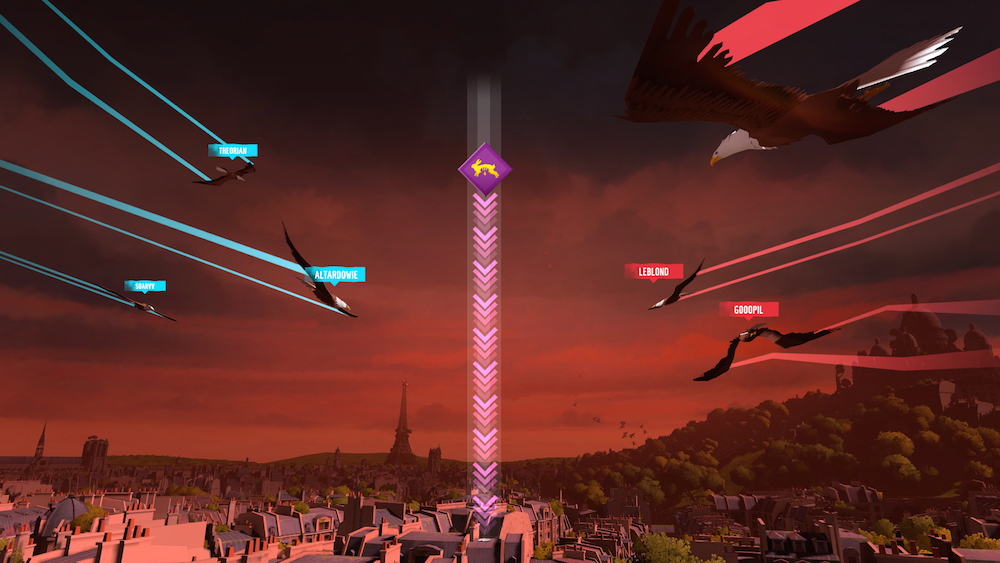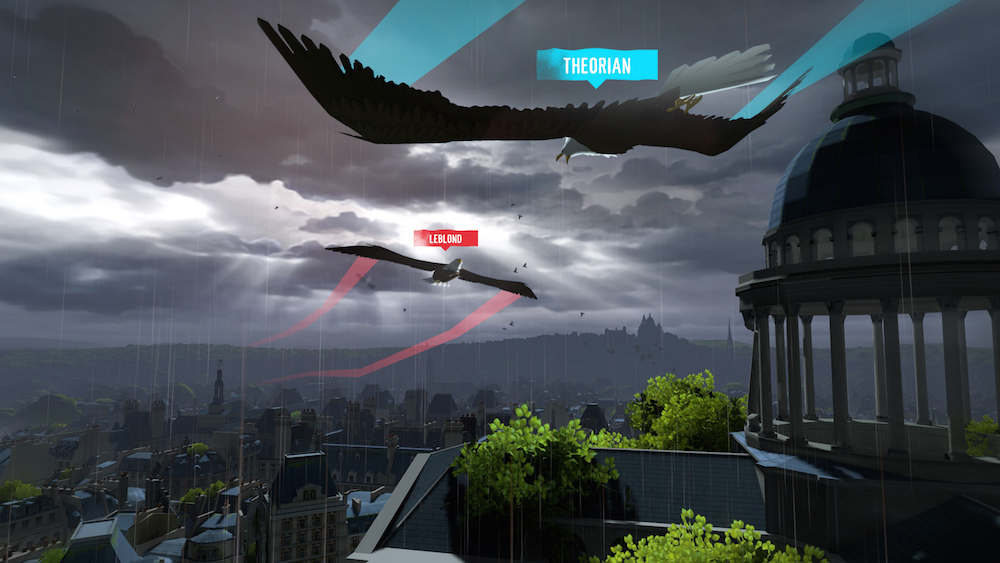“The tilt is a way of life.”
This is a line pulled from the original review guide we were sent for Eagle Flight when it first released on the Oculus Rift. The slightly-awkward French translation is fitting coming from the Montreal offices of Ubisoft, but it is also the perfect summation for the game itself. Since then, the eagle flying experience has also released on the PlayStation VR and HTC Vive platforms.
In Eagle Flight you take control of a young eagle with the simple goal of building its nest on the tallest point it can find amidst the overgrown ruins of Paris in the far future. This may sound like a story book premise, but it’s really just a loose narrative thread that allows for some truly remarkable gameplay.
Even though it doesn’t take place in a plane or spaceship, Eagle Flight is one of the most enjoyable entries yet in the increasingly crowded ‘cockpit shooter’ genre of virtual reality games. It earns that title through adrenaline packed dog eagle fights, tightly tuned flight mechanics, and memorable exploration.
Some games are built around interesting stories and others are born from unique mechanics; Eagle Flight falls firmly into the latter category. Flight direction in this game is completely controlled through the movements of your head. The left and right triggers on your gamepad will slow you down and speed you up respectively, but the hook of Eagle Flight is all about using natural motions to determine a flight path. If you’re playing on Vive, the motion controllers are not supported at all — you will be required to use a standard gamepad of some kind, such as an Xbox One controller.
The result of this innovative movement system is a wonderful feeling of both immersion and control. My brain never truly believes that the minor twitches of my thumbs on a gamepad are enough to pilot a massive spaceship or a WWII-era fighter plane. But it embraced wholeheartedly that I had become an eagle and this notion was reinforced with every movement of my head.
The now foliage-covered buildings, alleyways, and canals of Ubisoft Montreal’s take on a futuristic Paris are a delight to explore with this movement system. You feel truly impressive each and every time you thread the needle through a narrow gap or pull out of a steep dive at the exact right moment. The environments themselves are also beautifully designed and its a pleasure just to fly around and explore.
The head tilt steering is not the only innovation that Ubisoft Montreal packed into this package. It also designed a special narrowing mechanic for combating motion sickness. Essentially, the full field of view in your headset is never fully utilized in Eagle Flight. A portion of the screen always remains darkened. As you turn, these shadows will shift dynamically along with your viewpoint. The purpose of this system is to combat motion sickness during gameplay.
The shadows do their job perfectly. Motion sickness is essentially a non-issue for Eagle Flight, which is saying quite a bit for a game that wants to make your brain believe it is flying, even though your body knows that it is not.
All of these carefully crafted mechanics are put to good use in Eagle Flight’s two main game modes: single player and online multiplayer.

The story mode is fairly elementary. You, as a young Eagle, glide around Paris, completing missions and unlocking more of the city. These challenges may test your flight precision or your combat ability but none of them are very hard. You only need a basic, one-star rating to “beat” any of these challenges so difficulty is never really a problem and progression happens almost automatically. There are also “expert challenges” which are a bit tougher and require more stars for you to achieve a victory.
The single-player campaign may be a tad basic, but — much like Call of Duty or other modern games — it is merely the wrapping paper around the true present: online multiplayer.
This mode is essentially capture the flag. Two teams of opposing eagles race to pick up a “prey” that they then must carry safely back to their base to score a point. It sounds simple until you realize the other team will be barreling in to attack you with ultrasonic squawks that can knock the prey out of your beak and force you to respawn before getting back in the game.
These suped up bird calls can be fired like cannonballs. They actually require a good bit of skill to aim and that — combined with all of the dodging and diving you’ll be doing — adds up to a multiplayer experience that nails the sweet spot of being “easy to understand, but difficult to master,” that most online games are striving for.
Capture-the-prey is also Eagle Flight’s only online game mode, which feels a bit disappointing in light of the also sparse single player. It’s fun to play, but after a few rounds you do start to wish there was something else to try with your friends.
The lack of interesting directives is Eagle Flight’s biggest overall problem. The mechanics are innovative, it’s pioneered a very effective movement system that other VR games should absolutely pay attention to, and the combat is well thought out and fun, but the end result is still a title that leaves your plate feeling slightly empty.
Update: Since its original release on the Oculus Rift, Eagle Flight has also released on the PSN Store for PlayStation VR and will be available on HTC Vive via Steam. The game plays virtually identically on all three platforms, as it requires a standard gamepad regardless of your headset of choice. The visual fidelity feels slightly higher on the PC-based headsets, but the PS VR version is fully-featured and capable. Multiplayer is cross-platform across all devices, hopefully alleviating much of the low population problems that plagued the game at launch.
Eagle Flight is a great game that deserves to be celebrated for its many innovations and unique approach to VR. However, these core ideas would fly a lot higher if there were more ways to utilize them. What is here, however, is a real treat to play and shouldn’t be overlooked by anyone aching with an urge to soar through the skies.
Read our Game Review Guidelines for more information on how we arrived at this score.






























